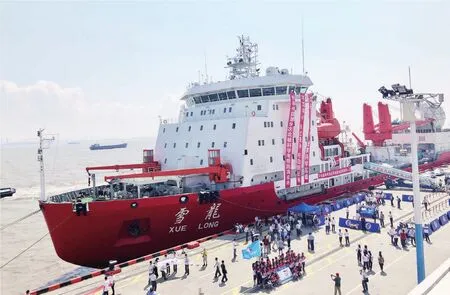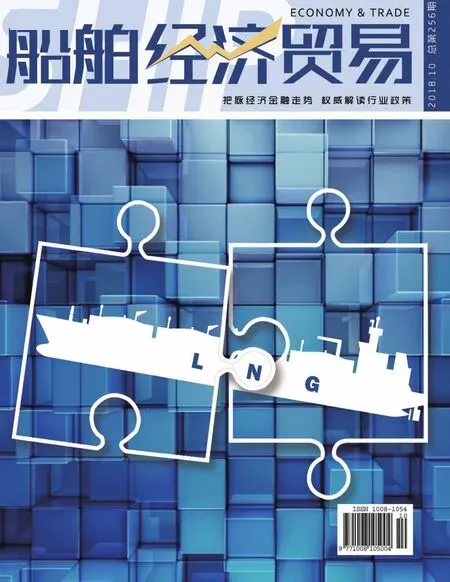Stories Behind “Xue Long 2”Joint Design
By Li Yaner

China's first independently built polar research icebreaker “Xue Long 2” was launched in Jiangnan Shipbuilding (Group)Co., Ltd.on September 10. At first glance,“Xue Long 2” is a lot solider than his brother: when the ship is nearly the same in molded width, its total length is nearly 45 meters shorter than “Xue Long”, which means, the wide-bodied “Xue Long 2”will be more capable of breaking ice and scientific research.
CSSC No.708 Research Institute(Maric) Researcher and “Xue Long 2” Chief Designer Wu Gang received a recent interview of China Shipbuilding News journalist and disclosed some stories behind “Xue Long 2” design from the designer’s perspective.
Wise Decision A Decade Ago
In 1993, China purchased a former Soviet Union Arctic Ocean transport supply ship from Ukraine. After many retrofits,the ship became the only polar research icebreaker “Xue Long” in China.According to the age of the ship, “Xue Long” is the old horse in the stable, it switched to a new profession half-way,its scientific research and ice-breaking capabilities are not enough to meet the current needs of China’s polar research.
China officially kicked off the “Xue Long 2” new polar research vessel construction project in 2009, and the State Council established the basic principle of “domestic and foreign joint design,domestic construction”. “Can't China design a new generation of polar research vessels on its own?” This was controversial in the industry. “In fact, it is very wise for the State Council to set the tone for Chinese and foreign joint design.” Wu Gang said that at that time, the understanding of polar ships by domestic ship designers was only in the theoretical stage, lacking practical experience and argumentation conditions.
That a foreign company undertakes basic design does not mean we merely buy drawings. “If we do not do enough research in early stage, even if we have bought drawings, we still could not learn a lot of things.” Wu Gang said the shipowner was also aware of this, and before identifying the foreign design company, they chose Maric with rich experience in the design of scientific research vessels as the technical support unit to participate in the newbuilding project throughout the process. In 2012,three companies from Germany, Norway and Finland participated in the bidding for the “Xue Long 2” basic design project.The shipowner invited an international bid evaluation team composed of experts from China, Korea, Canada, etc. Among them are academicians Zhang Bingyan and Wu Gang from Maric.
“After a round of comparisons, we found that none of the three companies'design proposals could meet the custommade requirements of the Chinese scientific research icebreaker.” Wu Gang disclosed that the bidding once stopped during the period.
Focus on Icebreaking Design Back to Aker Arctic
What are the custom-made requirements of China?
China's custom requirements are:That the "chassis" of the new generation of scientific research icebreaker must be good enough to ensure that it is strong enough for navigation in ice zone for many years, and that in order to improve the ship's ability and flexibility to break ice, “Xue Long 2” should adopt the full rotary propulsion mode.

“After further defining the demand,the bid evaluation team focused on the Finnish Aker Arctic Technology Inc.” Wu Gang recalled, "Aker Arctic Technology Inc.'s understanding of the ship form was close to the shipowner's idea, its hull design was done well enough to achieve full rotary propulsion, and the ship's ice-breaking power was small and the effect was very good.”
“Now that full rotary propulsion has been achieved, the stern should also be used as the bow of the ship.” The shipowner further put forward the idea of“two-way ice-breaking”, which was considered accomplishable through analysis and discussion between Maric and Aker Arctic. “A significant benefit of full rotary propulsion is that ‘Xue Long 2’doesn't need to turn in pressure ridge ice waters.” The distribution of horizontal ice and pressure ridge ice in polar waters is very complex, Wu said, and even seemingly open waters can sometimes make it difficult for ships to move due to a large amount of soft and difficult pressure ridge ice hidden under the water. Therefore, the bidirectional ice breaking indexes of “Xue Long 2”are determined as follows: the heading of bow breaks ice continuously at a speed of 2-3 knots on a 1.5 m thick ice layer covered with 0.2 m thick snow; stern breaking ice 20 meters in the current year of ice ridge(including 4 meters of accumulation) will not be stuck. “Xue Long 2” became the world's first polar survey vessel with twoway ice-breaking capability.
On July 31, 2012, the State Oceanic Administration, China Polar Research Center, and Aker Arctic, Finland, signed a contract for the basic design of polar scientific research icebreaker.
Scientific Research and Open Water Design Has Still to Rely on Maric
After the basic designer was identified, new problems cropped out.
“From March to July of 2012, the design team of Maric and Aker Arctic began a lengthy exchange and negotiation on various professional issues.” Wu Gang said the main problem of the Aker Arctic design scheme lies in its lack of experience in the design of scientific research vessels.The original model ship was a cargo ship and could not meet the requirements of the scientific research ship in terms of ship stability and other aspects; in addition,there is a lot of open water between China and the polar region, but the original scheme had shortcomings in this field.”At this time, Maric design advantages of scientific research vessel and open water area were revealed,” said Wu Gang.
The "Yuan Wang" series and"Xiang Yang Hong" series designed by Academician Xu Xueyan and Academician Zhang Bingyan respectively from Maric are outstanding scientific research ship forms in China. Maric design advantages have been inherited in the new generation of Chinese scientific research icebreaker projects. Important acoustic equipment installed at the bottom of “Xue Long 2”is vulnerable to bubbles and crushed ice.Therefore, Maric specially designed the bottom structure of the sinking keel.“Aker Arctic gave us feedback that this design not only solved the problem of crushed ice discharge interference, but also did not have a significant impact on the economy of the ship's navigation,” said Wu Gang.Compared with other merchant ships, oil consumption of the icebreaker in open water area is higher. Therefore, Maric optimized the ship's ice pressure angle, ice discharge angle and line type by utilizing the experimental advantage of towing tank. “On the ‘Xue Long 2' project,Maric and Aker Arctic were integrated and concomitant.” Wu Gang said that the two sides have developed their respective technological advantages and learned from others’ strong points to offset own weaknesses. In the design of ice breaker and the application of cold prevention,Maric also learned a lot from Aker Arctic


On October 22, 2012, the China Polar Research Center signed a detailed design contract with Maric on new polar scientific research icebreaker project in China.
Inspiration and Practice from a Trip to the South Pole
Wu Gang went to the South Pole for survey along with “Xue Long” at the beginning of 2015 for the purpose of “Xue Long 2” design. After more than 70 days'trip to the South Pole, Wu Gang's greatest feeling was that “Xue Long 2”, which focuses on scientific research, must provide a more scientific and convenient working environment for researchers.
“Because of the ship form, our researchers' work mode is too backward.” Wu was impressed by the fact that scientists had to get themselves to the starboard side of “Xue Long” to retrieve the hundreds-of-kilogramweight water collecting device from water. On one hand, working on the deck is dangerous in polar conditions; on the other hand, precious water samples are exposed to extreme cold temperatures for long periods of time, leaving them at constant temperatures can lead to biological death in the samples, thus affecting the results of scientific research. After coming back from the Antarctica, Wu Gang led the Maric design team in designing special sampling rooms and equipment, which not only improved the working efficiency, but also ensured operation safety of scientific research personnel.
“Scientists once told us that they hoped China's scientific research vessels would be in line with foreign countries,and that they could concentrate on experiments on board, and even be able to operate scientific research equipment while drinking coffee.” Wu Gang said that “Xue Long 2” has adopted a centralized laboratory pattern, a largescale workshop and a large area of survey deck design, coupled with the application of the lunar pool system in the ice area,can achieve the maximum compatibility and sharing of the ship investigation and experiment functions and be overall in line with the international professional polar ocean survey arrangements and procedures. “Scientists on ‘Xue Long 2’no longer need to do extra manual work, in fact, with improvement in the mechanization and automation of scientific equipment on board, we need to train more professional operators of scientific equipment to assist scientists,”said Wu Gang.
“Another deep feeling I had on ‘Xue Long’ was that the communications equipment on board really needed to be improved.”Wu Gang said, that “Xue Long 2” achieves full WLAN coverage reflects “Xue Long 2” humanized design. It is understood that “Xue Long 2”can bring more comfortable experience to the crew on board on the following aspects-- shift duty for the driver, the protection and convenience of the laboratory and deck scientific research work, the reasonable setting of the fitness activity place, the insulation, ventilation and shading of rooms, and the anti-slip treatment of the outdoor stairway, the design of toilet vacuum system, condensate water treatment, setting of tea station, garbage room, baggage room, laundry room and convenient transportation of vegetables,fruits and fresh water.
Through the “Xue Long 2” project,Maric has accumulated experience in the rules and regulations of polar ships, and has mastered the key technologies such as the design of the bi-directional icebreaker ship form and the structure design of the Class PC3 icebreaker and the cryogenic design of the icebreaker, and has built an increasingly mature scientific research ship design team.

- 船舶经济贸易的其它文章
- Jiangnan Shipyard Building LNG Industrial Chain
- With Right Wind, Raising the Sail of Blue Economic Development
- Enhancing Comprehensive Capability of LNG Carrier Industrial Chain to Ensure Implementation of National Clean Energy Strategy
- 淡季不淡行情稳中向好2018年9月中国沿海(散货)运输市场分析
- 需求平稳增长航线走势分化2018年9月中国出口集装箱运输市场分析
- 原油交易减少运价总体上涨2018年9月世界油货运输市场分析

